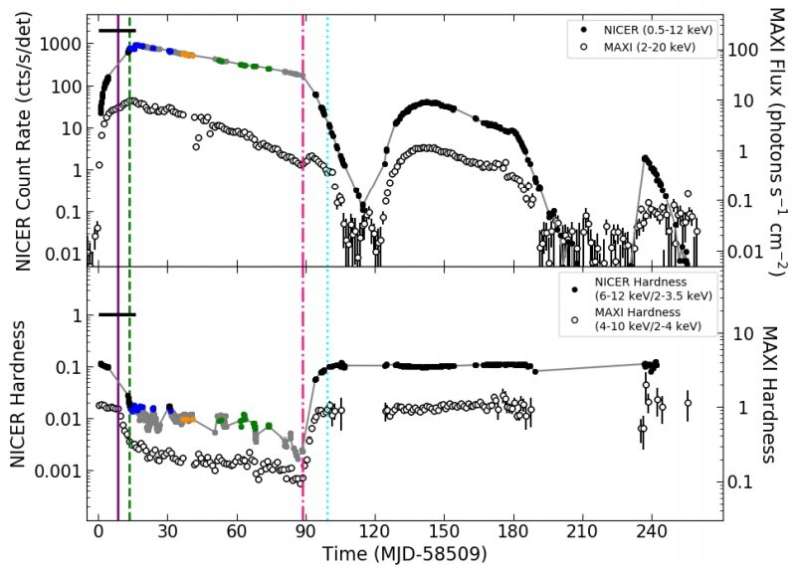September 28, 2020 report
MAXI J1348−630 is a black hole X-ray binary, observations suggest

Using the Neutron Star Interior Composition Explorer (NICER), an international team of astronomers has investigated a recently discovered X-ray transient designated MAXI J1348−630. Results of the new observations suggest that the source is a black hole X-ray binary. The study is detailed in a paper published September 16 on arXiv.org.
X-ray binaries (XRBs) consist of a normal star or a white dwarf transferring mass onto a compact neutron star or a black hole. Many black hole XRBs show transient events that are characterized by outbursts in the X-ray band.
During these outbursts, astronomers observe mainly the hard and soft spectral states. In the hard state, the spectrum is dominated by a power law-shaped continuum, while in the soft state, the spectrum is dominated by a disc-blackbody emission. However, some black hole XRBs also exhibit an intermediate state in which the hard power-law continuum and a disc thermal emission component make approximately the same contribution to the total spectrum.
MAXI J1348−630 is an X-ray transient discovered on January 26, 2019 with the Gas Slit Camera (GSC) of the Monitor of All-sky X-ray Image (MAXI) aboard the International Space Station (ISS). Follow-up observations of this source suggest that it is a black hole candidate in a binary system.
Recently, a group of astronomers led by Liang Zhang of the University of Southampton, U.K., has published a new study supporting the black hole scenario. The research is based on the results from NICER monitoring of MAXI J1348−630 between January 26 and October 8, 2019.
"We studied the outburst evolution and timing properties of the recently discovered X-ray transient MAXI J1348−630 as observed with NICER. We produced the fundamental diagrams commonly used to trace the spectral evolution, and power density spectra to study the fast X-ray variability," the researchers explained.
In general, the researchers found that the spectral evolution of MAXI J1348−630 during its main outburst is similar to what was previously reported for other black hole transients. The source went from the hard state, through the hard-intermediate state and soft-intermediate state, into the soft state in the outburst rise. Afterward, it went back to the hard state in the outburst decay. They noted that the transition from hard to soft state was very fast.
Furthermore, they detected two re-flares of MAXI J1348−630. These occurred at the end of the main outburst and had peak fluxes one and two orders of magnitude fainter than the main bursting event, respectively. The results show that the source remained in the hard state during the re-flares, never making a transition to the soft state. The astronomers noted that such behavior resembles the so-called "failed outbursts"—those generally less luminous at their peak, not showing any evidence of state transitions, and which are observed in many black hole transients.
The study also found quasi-periodic oscillations (QPOs) in MAXI J1348−630. They detected different types of low-frequency QPOs at different phases of the main outburst.
According to the authors of the paper, all the results from NICER monitoring strongly support the hypothesis that MAXI J1348−630 contains a black hole.
More information: NICER observations reveal that the X-ray transient MAXI J1348−630 is a Black Hole X-ray binary, arXiv:2009.07749 [astro-ph.HE] arxiv.org/abs/2009.07749
© 2020 Science X Network





















